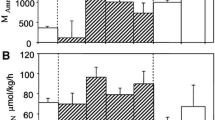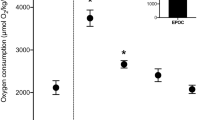Abstract
Specimens of Nautilus pompilius were trapped at depths of 225–300 m off the sunken barrier reef south-east of Port Moresby, Papua New Guinea. Animals transported to the Motupore Island laboratory were acclimated to normal habitat temperatures of 18 °C and then cannulated for arterial and venous blood sampling. When animals were forced to undergo a period of progressive hypoxia eventually to encounter ambient partial pressure of oxygen (PO2) levels of ∼10 mmHg (and corresponding arterial PO2's of ∼5 mmHg), they responded by lowering their aerobic metabolic rates to 5–10% of those seen in resting normoxic animals. Coincident with this profound metabolic suppression was an overall decrease in activity, with brief periods of jet propulsion punctuating long periods of rest. Below ambient PO2 levels of 30–40 mmHg, ventilatory movements became highly periodic and at the lowest PO2 levels encountered, ventilation occasionally ceased altogether. Cardiac output estimated by the Fick equation decreased during progressive hypoxia by as much as 75–80%, and in the deepest hypometabolic states heart rates slowed to one to two cycles of very low amplitude per minute. By the end of 500 min exposure to ambient PO2 levels of 10 mmHg or less, the anaerobic end products octopine and succinate had increased significantly in adductor muscle and heart, respectively. Increased concentrations of octopine in adductor muscle apparently contributed to a small intracellular acidosis and to the development of a combined respiratory and metabolic acidosis in the extracellular compartment. On the other hand, increases in succinate in heart muscle occurred in the absence of any change in cardiac pHi. Taken together, we estimate that these anaerobic end products would make up less than 2% of the energy deficit arising from the decrease in aerobic metabolism. Thus, metabolic suppression is combined with a massive downregulation of systemic O2 delivery to match metabolic supply to demand.
Similar content being viewed by others
Author information
Authors and Affiliations
Additional information
Accepted: 26 January 2000
Rights and permissions
About this article
Cite this article
Boutilier, R., West, T., Webber, D. et al. The protective effects of hypoxia-induced hypometabolism in the Nautilus . J Comp Physiol B 170, 261–268 (2000). https://doi.org/10.1007/s003600000096
Issue Date:
DOI: https://doi.org/10.1007/s003600000096




